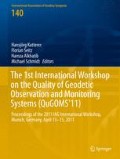Abstract
Net adjustment is one of the basic tools for various surveying tasks. Among the transformation of coordinates or the analysis and comparison of geometries, the adjustment of geodetic networks is an important part of the surveyor’s work. The market offers a number of software solutions, both commercial and freeware.
Seeing the range of software solutions, the question arises, whether the programs give equivalent results. Earlier evaluations of net adjustment programs, partly including New River Kinematics’ SpatialAnalyzer (SA), revealed on the one hand almost identical adjustment results for the classic programs. On the other hand, the evaluations showed that SA, using a different mathematical model (bundle adjustment), yields clearly distinguishable deviations. Hence, in this paper the authors focused on SA with the classic programs as reference. The first part of the comparison deals with the results of evaluating a terrestrial network. As programs do not account for the earth’s curvature in a standardized way, the chosen network is of small size to minimize the influence of the curvature to an insignificant level.
The second part of the paper compares the results of the evaluation of basic geometries (plane, circle, cylinder, sphere) using SA and other software packages with the least squares solution obtained in a rigorous Gauss–Helmert model (GHM).
Access this chapter
Tax calculation will be finalised at checkout
Purchases are for personal use only
References
Calkins JM (2002) Quantifying coordinate uncertainty fields in coupled spatial measurement systems. PhD Thesis, The Virginia Polytechnic Institute and State University
Čepek A (2011) GNU Gama 1.11, Adjustment of geodetic networks. www.gnu.org
Drixler E (1994) Analyse der Form und Lage von Objekten im Raum. DGK series C, vol 409. C. H. Beck, Munich
Eschelbach C, Haas R (2003) The IVS-reference point at Onsala—high end solution for a real 3D-determination. In: Schwegmann W, Thorandt V (eds) Proceedings of the 16th working meeting on European VLBI for geodesy and astrometry, Leipzig, 9–10 May 2003. Federal agency for cartography and geodesy, Leipzig/Frankfurt am Main, pp 109–118
Grontmij Nederland bv (2011) move3 USER MANUAL, Version 4.0 (move3.com)
Illner I (1983) Freie Netze und S-Transformation. AVN 90(5):157–170
Jäger R, Müller T, Saler H, Schwäble R (2005) Klassische und robuste Ausgleichungsverfahren. Wichmann, Berlin
Lenzmann L, Lenzmann E (2004) Strenge Auswertung des nichtlinearen Gauß-Helmert-Modells. AVN, 2/2004. Wichmann, Berlin, pp 68–72
Lösler M, Bähr H (2010) Vergleich der Ergebnisse verschiedener Netzausgleichungsprogramme. In: Zippelt K (ed) Vernetzt und Ausgeglichen. Kit Scientific Publishing, Karlsruhe
Neitzel F (2010) Generalization of total least-squares on example of unweighted and weighted 2D similarity transformation. J Geod 84(12):751–762
Schwieger V, Foppe K, Neuner H (2010) Qualitative Aspekte zu Softwarepaketen der Ausgleichungsrechnung. In: Qualitätsmanagement geodätischer Mess- und Auswerteverfahren. Contributions to the 93rd DVW-seminar. Series of the DVW, vol 61
Späth H (2000a) Ein Verfahren zur Bestimmung des Least-Squares-Zylinders. AVN, 2/2000. Wichmann, Berlin, pp 65–67
Späth H (2000b) Ausgleich mit einem Kreis im Raum. AVN, 11–12. Wichmann, Berlin, pp 398–399
Witte B, Schmidt H (2000) Vermessungskunde und Grundlagen der Statistik für das Bauwesen. Wittwer, Stuttgart
Acknowledgments
The authors thank COS Geoinformatik GbR for providing the measurement data of the network. Furthermore they thank Alexander Hiller of VMT GmbH as well as Scott Sandwith and Joseph Calkins of New River Kinematics for the open discussion and help.
Author information
Authors and Affiliations
Corresponding author
Editor information
Editors and Affiliations
Rights and permissions
Copyright information
© 2015 Springer International Publishing Switzerland
About this paper
Cite this paper
Herrmann, C., Lösler, M., Bähr, H. (2015). Comparison of SpatialAnalyzer and Different Adjustment Programs. In: Kutterer, H., Seitz, F., Alkhatib, H., Schmidt, M. (eds) The 1st International Workshop on the Quality of Geodetic Observation and Monitoring Systems (QuGOMS'11). International Association of Geodesy Symposia, vol 140. Springer, Cham. https://doi.org/10.1007/978-3-319-10828-5_12
Download citation
DOI: https://doi.org/10.1007/978-3-319-10828-5_12
Published:
Publisher Name: Springer, Cham
Print ISBN: 978-3-319-10827-8
Online ISBN: 978-3-319-10828-5
eBook Packages: Earth and Environmental ScienceEarth and Environmental Science (R0)

